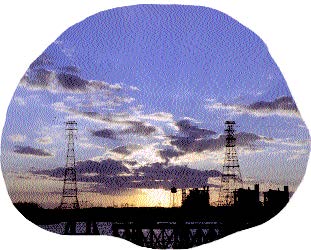- Where to stand: Mississippi Levee
- Located: Between Magazine and Industrial Streets
- Ideal time: 6:30 to 8:00 pm
- Colors to expect: vermilion, aquamarine, beef stock brown
- Material: Stainless steel
Before the light fails in New Orleans it succeeds in pretty fair style for about an hour and a half. The trouble is that the city sits in a deepening meniscus of land, and the good light has a hard time finding its way into the deeper reaches of New Orleans proper. So the best place to go, when twilight is breaking, is the top of the Mississippi levee, which offers the only (semi) natural vista in town.
In advance of any scenic reddening, the light turns flat and weary. The ibises in Audubon Park are the first to notice the degrading ambience. Most of them take to the cypresses in the park’s lagoons, but a few loner ibises fetch up in the trees along the levee, looking like pale, windblown garbage.
After ten minutes or so, things start getting reasonable. The sun sags below the line of sycamores on the top of the levee, and steeples of blue shade creep slowly down the bank. The shady bits are evenly interspersed with angles of light, like a backgammon board.
The sunlight is fairly vermilion now. A Welsh corgi, sprinting from the shadows into a jag of light, looks suddenly oxidized. Populations of joggers, walkers and cyclists appear on the asphalt path that runs along the levee’s ridge. A woman in a wheelchair is cruising so athletically that the terrier lashed to the chassis is having a hard time keeping up. Ladies and gentlemen spread out blankets in the short weeds. A jogger runs past me. Some of the light has spilled onto her neoprene shorts. I would like to have a conversation with her, but the only thing I can think to say is, “Your ass is hurting my feelings.”
The light is also helping the situation on the river’s west bank, which is home to a bunch of refinery-citadels in the Newark, New Jersey-mode. Even from a distance, you can make out big aortic curves and steam nozzles and ovipository pipettes. They are always amazing to look at, but now they are getting a rich drenching of Maxfield Parrish brilliance and they look especially nice.
The Mississippi itself does not look so good. It is a homely workhorse of a river, and the sherbet hues only make it look sad and slutty. One twilight concession is that the river’s deepest channel, by day the color of beef stock, has turned aquamarine. You would never want to try to swim it, but some people, who perhaps stopped by when the light was tempting, have given it a shot. A sign on the bank reads, “Members of our neighborhood have lost their lives swimming here.” It lists the names of seven children, ages ten to sixteen, who recently drowned. Then it says “If you find this sign destroyed please contact: Assessor Harry F. Heaton.”
Past the sign and past the jogging scene is a tiny neighborhood of stick-frame riverhouses. Tonight, a man is in his driveway, working on a basket of soft crabs. He is snipping off the crabs’ faces with poultry shears. A black dog is on hand, and the man is giving it faces to eat.
After the houses, the levee starts getting desolate. A pair of rusted smokestacks stick out of the earth. One is called “Vacuum Pumps 1 & 2” and the other is called “Vacuum Pumps 3 & 4.” They have lightbulbs on their trunks, secure in galvanized lightbulb cages, safe from vandals. They glow all night and you can see them, bright and clairvoyant, when you drive by on the river road. They turn on just as I am walking past, and this means the dusk is for real.





